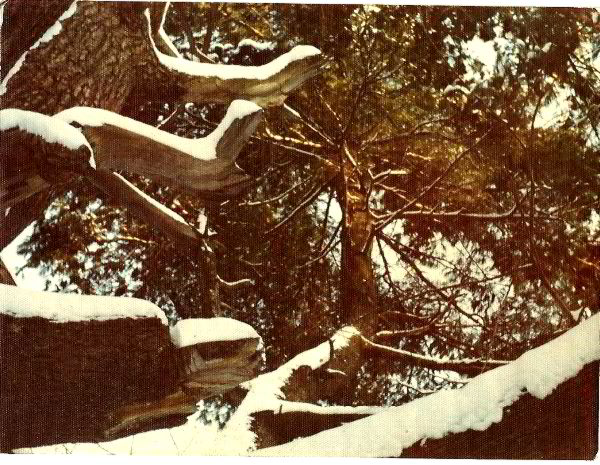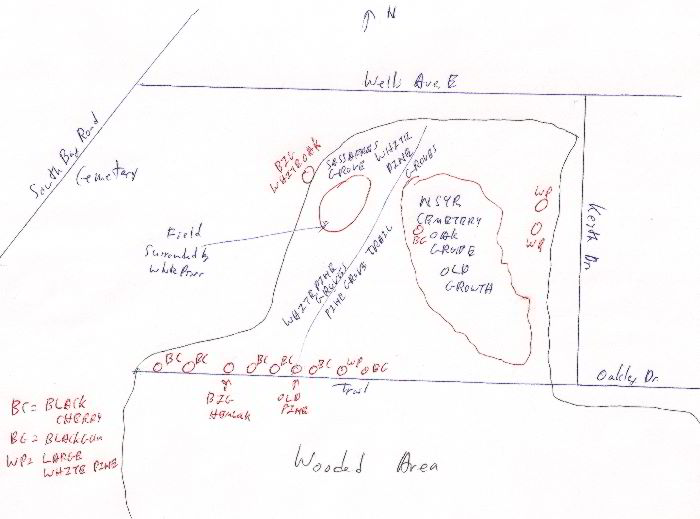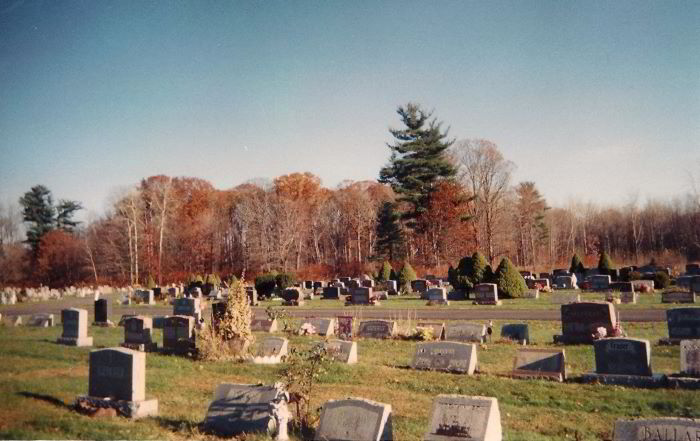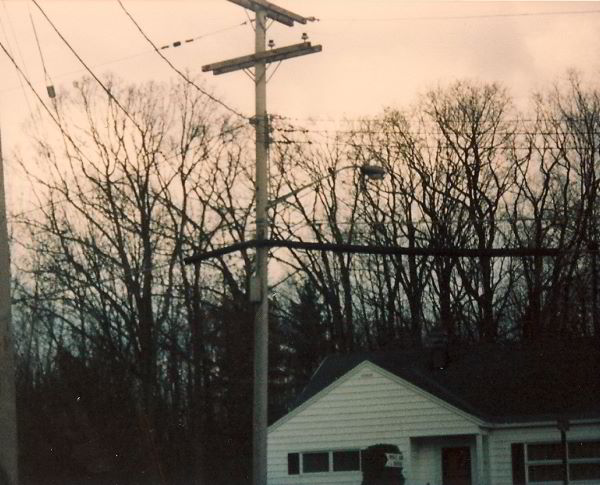|
ENTS,
Like James Parton I had a magical woods to explore in childhood;
the woods was right behind the house where I grew up on the east
side of North Syracuse. It covered almost 90 acres and was
basically an abandoned farm and apple orchard with open fields,
groves of Quaking Aspen and Red Maple, and a few isolated groves
of Sassafras. It was here that I learned how to identify trees,
but even more, it was a fabulous place to explore, to have
magical childhood adventures in, to pretend I was living through
many early periods of history, to search for hidden treasure, to
imagine that trees could talk to me. This was all many years ago
and what's left of the woods has been turned into housing
developments and an industrial park, and the less than 30 acres
left is mostly young second growth forest.
I say mostly second growth forest because not all the woods was
an abandoned farm. Most of the woods belonged to a real estate
developer but a small section near the west edge belonged to
(and still belongs to) the North Syracuse Cemetery Association,
and this section was pure magic and legend especially to a child
and I called that section "The Ancient Trees" as that's what
part of it still is. This section contains the old growth North
Syracuse Cemetery Oak Grove and I was only 5 years old when I
first walked among those great old trees. This section contained
not just the oak grove but a few even older trees, including a
battered old White Oak close to 5 ft. dbh (that fell in 1973 and
had open grown form), and above all 2 trees that stood in a 19th
century hedgerow that predated that time by many years. A White
Pine and 5 Black Cherries were planted in that hedgerow about
1870 (these dates come from core samples taken in 1997) and
around that hedgerow grew one of the most beautiful second
growth forests I've ever known with a great deal of White Pine,
including a field surrounded on 3 sides by spreading White Pines
and on the 4th side with a grove of Sassafras and the old
battered White Oak mentioned above. All this is a vanished
landscape today due to the expansion of the cemetery so all
that's left is the old growth oak grove.
And about the 2 old trees in the hedgerow - they were the most
precious trees of my childhood. One of them which we always
called the "Old Pine" was the biggest tree in all the woods, a
craggy battered old giant with huge spreading limbs; in 1970 we
measured a cbh of 10 ft. 2 in., and the estimated height of the
tree was about 90 ft. with a branch spread of 90 ft. or more.
Tragically this great and wonderful White Pine is no longer with
us as it fell in a powerful wind storm in Apr. 1979. A few years
later I examined the tree's remains, found that the stump had
rotted through but its biggest limb was still intact and I
easily counted 270 rings on the cross-section of the branch,
making the Old Pine substantially older than the old growth
oaks of the nearby grove. The other old tree was a Hemlock 8 ft.
6 in. cbh (in 1970) and I counted over 180 rings on the intact
part of its stump; the tree was probably about 300 years old.
According to my best estimate the Old Pine lived from about 1690
to 1979 - it would be a good tree for an ENTS Memorial.
Even in the large younger part of the woods were a few big
trees, including a Basswood that never bloomed and had 7 trunks,
was possibly a 19th century coppice, and next to it was a Black
Gum at least 2 ft. dbh, and in another area was a grove of pure
Shagbark Hickory surrounding a parent tree over 2 ft. dbh, and
in another area a Black Willow with a single trunk close to 80
ft. tall.
I'm enclosing a few pictures of the Old Pine and its area:
First is the most precious site in the world to me - the edge of
the woods from North Syracuse Cemetery in 1967. This is a
vanished landscape. The Old Pine is in the center and to lower
right of the tree what looks like a lower young White Pine is
actually a branch of the great old tree. To the right is the
tree we've always called the Big Hemlock ( the Big Hemlock was
cut down in 1989); flanking the Pine and Hemlock are the Cherry
trees planted about 1870.
The next photo shows the Old Pine in 1970, and the next one
after that is a look into the Old Pine's crown on a bitter
winter day in 1975 - the center of the picture is filled with
the Pine's biggest limb (the limb on which I counted 270 rings).

The dominant trees were Red Maple and Black Gum (outside of
North Syracuse a rare tree in central NY but in the brushy
second growth areas of the woods it was everywhere) with Quaking
Aspen dominating in groves that we called "Poplar Groves" -
these groves were the most important features of the landscape.
The terrain was flat except for hills that were made when a long
drainage ditch was dug in the far part of the woods; we called
this ditch the "Krik" and it represented the wild back of beyond
to me as a child; it was a jungle-like area with trees a little
larger than in most of the rest of the woods.
Beyond the Krik was a "wilderness" that extended to a farmer's
field - it was in this area where the giant Black Willow was.
This whole landscape has vanished to be replaced by an
industrial park and houses.
The woods had quite a few tree species including Black Cherry,
Red Oak, Black Oak, White Oak, Ash which were common and some
rarer (at least for this site) species like Sassafras, Bigtooth
Aspen, Cottonwood, Hornbeam, Black Birch, Gray Birch, Yellow
Birch (that species only in the area in and near the old growth
N. Syracuse Cemetery Oak Grove), White Pine (common only in the
area near the Old Pine and into the field past the Cemetery Oak
Grove), Hemlock (only near the Big Hemlock), Basswood (the
Basswood mentioned in the first post stood in a grove of Aspen
called the "Basswood Poplar Grove" and the only other Basswoods
were in the area beyond the Krik), Shagbark Hickory (one tree
possibly 18" dbh in Basswood Poplar Grove, all others beyond
Krik).
I'm enclosing a map I made of the area around the North Syracuse
Cemetery Oak Grove about 1970 showing the relationship of the
oak grove to the Old Pine, Big Hemlock, and other trees. Oakley
Dr. is the street where I grew up.

First is a view of the North Syracuse Cemetery Oak Grove from
Nov. 2009. The Old Pine, Big Hemlock and other trees in the 1967
photo is now an area filled with graves to right of the oak
grove, a generic cemetery replacing the wonder that existed in
my childhood.

Next is of the Basswood mentioned in yesterday's post - the only
Basswood I've known never to bloom. (1976)

The last picture is of the Cemetery Oak Grove towering over the
houses of the Keith Dr.-Oakley Dr. corner, a view that still
exists today.

Tom Howard
Continued at:
http://groups.google.com/group/entstrees/browse_thread/thread/a2ba182ff6b6c065?hl=en
http://groups.google.com/group/entstrees/browse_thread/thread/a36caadea6b199d5?hl=en
|